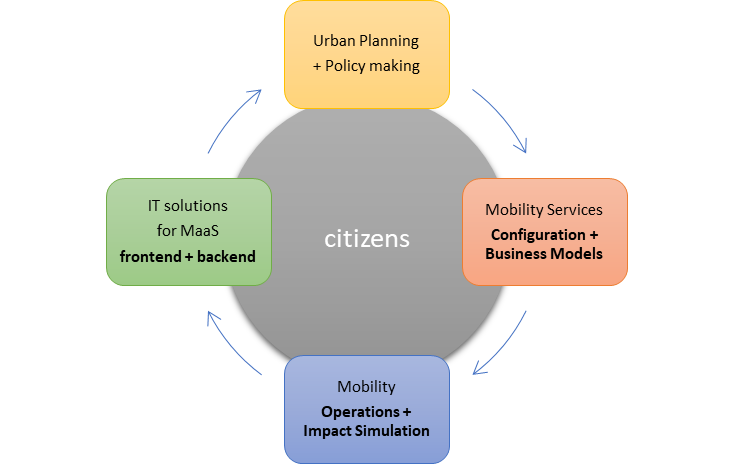OptiMaaS – Optimized Mobility as a Service
Holistic mobility solutions for the urban periphery
The availability of mobility offers and services and the predominant spatial structures, largely determine citizens’ mobility behaviour. In particular the urban periphery continues to be heavily car reliant resulting from a low public transport service quality and availability of it. Furthermore the EU and its member states committed themselves to cut CO2 emissions by at least 40% by 2030 and by 80% by 2050.
With the transport sector accounting for one quarter of CO2 emissions, there is a need to radically transform the way people and goods are transported and how traffic works. At the same time, already 75% of the European population live in cities and urban areas, transforming them into challenging hotspots not only for traffic management.
OptiMaaS aims to assist the EU task of reducing CO2 emissions and also lower the congestion through better multimodal, environmentally friendly mobility services in the urban periphery. At the same time, transportation in city periphery needs to become more versatile, demand-responsive accessible for all at low costs and at the same time flexible to be shaped by city policies.

Citizens’ needs: As cities and surrounding areas grow, the price of housing units that are connected to good or excellent transport connections rise significantly. One major reason for urban sprawl are lower housing prices but a challenge often overlooked is the trade-off between residence location costs and mobility costs: Although residential costs in peripheral urban areas are generally lower, one has to ride longer distances to reach work, education, social- or recreation facilities which results in higher expenses for mobility.
MaaS solution: Recent efforts to tackle the challenges described above have brought up a new breed of providers for combined mobility services (CMS) and business models. Despite the lack of a commonly agreed definition those MaaS-Systems (Mobility as a Service-Systems) are defined as traffic service including public transport in combination with other transport modes (taxi, car-sharing, bike-sharing etc.). This combination is facilitated through the use of IT-Platforms “that link the respective service providers and bundle existing mobility offers”¹ (Arbeithuber 2017) while at the same time ensuring route optimization following different strategies (most environmentally friendly, fastest, cheapest route, etc.). Although MaaS opens huge opportunities to overcome the urban mobility challenges, there are still open questions limiting advantages for Cities: “MaaS has largely been driven forward by digital and ITS industries and the personal transport sectors of car-sharing and taxis. The role of the wider public transport sector appears to have been minimised, which is a major issue for city and regional authorities as mass transit is the backbone of mobility”² (Polis 2017). Therefore, new solution paths need to be developed.

Project goals: Based on the current challenges in European cities – especially in urban periphery – OptiMaaS explores and develops new tools, processes and business models in a multi-stakeholder process, focusing on citizens’ needs. By linking the know-how of urban and mobility service planning, public and private mobility operators with IT developers for MaaS, we aim at providing an integrated approach to effectively use and implement MaaS services, where they are needed most. Overall, the OptiMaaS project will improve the dissemination and social acceptance of MaaS-offers and builds a common ground for new, data-driven governance and city planning policies. Overcoming barriers between silos such as planning, business, operations, communication and IT-solutions will be manifested in new forms of cooperation between parties.
- The first objective is to identify where and for whom MaaS-offers can be implemented in urban periphery and how an adequate MaaS-operator-landscape, can be set up there.
- The second objective is to develop a methodology and testing which kind of mobility services best fit citizens’ demands, which degree of availability is needed and how to best communicate and promote the market.
- Thirdly new simulation methods to measure the impact of incentives within personalized MaaS-routing policies will be developed.
Overall, the OptiMaaS project helps improving the dissemination and social acceptance of MaaS-offers and builds a common ground for new, data-driven governance and city planning policies.
¹ARBEITHUBER, S., 2017, Business models of shared mobility, Master’s Thesis, LIMAK Austrian Business School, Linz, Austria.
²POLIS, European Cities and Regions Networking for Innovative Transport Solutions, 2017: Mobility as a Service: Implications for urban and regional transport.